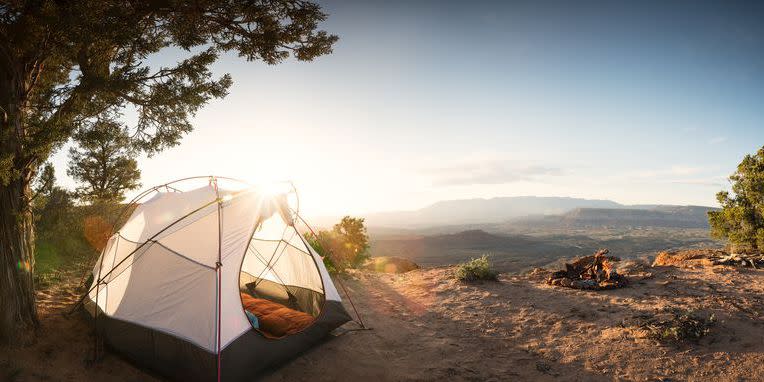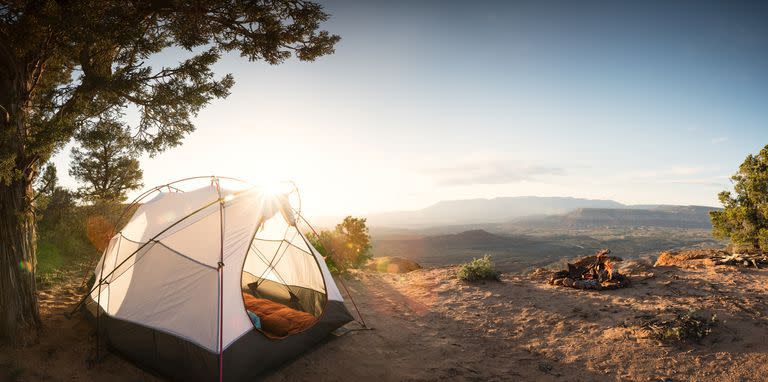The Best Tents for Camping and Backpacking


There's nothing like a home away from home, and a great tent is a key part of a successful campout or hike into the backcountry. We've gathered a range of our favorite tents that you'll want when you head to the campground.
(Also check out our guide to roof top tents.)
For those experts who want the absolute lightest pack, it doesn't get much lighter than the 1 lb. 5 oz. Big Agnes Tent. Dyneema based fabric and a carbon fiber pole do the dirty work of keeping weight down while staying strong and waterproof. With one pole construction, its even easy to set up. Just be careful, if you're rough with the thin material it can abrade and tear.
A completely mesh wall design will keep you cool even on the hottest, muggiest nights, and a rainfly that goes to the ground will keep you dry on the rainiest nights. Ample room in the vestibule for your gear, and enough room inside to sit up. At just over 5 lbs, its a great weight to split between two backpackers as well.
You can easily spend hundreds of dollars on a tent, but that may be more than is necessary if you're just taking a couple of trips to a campground each year. Coleman's tents have long been a standby, and its Sundome 4 model gets consistently good customer reviews on Amazon and other sites. The tent's dome design makes for a relatively easy setup, and you'll get plenty of ventilation from the tent's mesh vents and large rear window. Sundome tents comes in different sizes, accommodating 2, 3, or even 6 people.
Another highly-rated tent from Big Agnes is the Copper Spur HV UL 4, which Backpacker magazine liked enough to call the "most livable group tent out there." At $650, it's not exactly inexpensive, but it's easy to set up and will house four adults comfortably. Backpacker also notes that the "weatherproofing is superb" as it holds its own against wind, rain, and snow. Like the Blacktail 3, it also has mesh pockets designed with portable devices in mind, and it's incredibly lightweight for its size, at just over five pounds.
This tent from Browning has enough room for everyone, and even a bit of separation. A wall in the middle of the tent creates two rooms, both of which full grown adults can stand in. There are also two doors. You might be able to hear each other, but now you won't have to worry about a sock disappearing into the explosion around one of your kid's bags. At over 34 lbs, this is firmly a car camping tent.
Big Agnes' tents are a favorite of many, including The Wirecutter, which rated the company's Blacktail 3 as its best overall tent for camping. They liked the tent's light weight and use of high-quality materials, as well as its well-thought-out storage options, including internal mesh pockets that let you run headphones to your smartphone or tablet. It's also a good choice if you're looking for something to bridge the gap between backpacking tents and car camping tents.
We tried out this tent while camping in upstate New York. Its color coding makes it a breeze to figure out assembly, while the two-door setup makes it easy to exit without crawling over somebody. Inside, the Vazquez Peak 3 has plenty of space for a trio, or for two people and their stuff. It's a great all-around three-season tent.
The Halo earns its name. This is a towering six-person tent that created a whopping 96 square feet of floor space and nearly vertical walls to create ample space inside. Poles encircle the top, creating the "halo" that's great for stargazing. This tent ain't cheap, but it's a good choice for the serious camper.
It's basically a house. The Eureka Copper Canyon 6 is so massive that six adults can comfortably walk around in it. The company also makes 8- and 12-person versions, the latter including a curtain to divide it into two room. If you're buying one of these, it's because size matters.
If you don't mind making a few trade-offs, Kelty's Grand Mesa 2 is a popular choice for an inexpensive backpacking tent. At four pounds, it's fairly lightweight considering the price and it's both easy to set up and move around once constructed. If you need a bit more room, the Grand Mesa 4 adds some extra square footage for not much more money, though it does add three pounds to the carrying weight.
For those who don't want to be on the ground, or are camping in rocky, or uneven terrain, hanging a hammock might just be the solution. Just find some trees and hangout. The asymmetrical design is also supremely comfy, allowing even side sleepers to get settled. Incorporated bug netting keeps bugs out but lets you slither in. While the rain fly looks small, its all you'll need.
If you've got a lot of gear, get a tent with a lot of space. The Axis has two 17 sq ft vestibules for all of your and your partner's gear. Inside is spacious too with a 44 in ceiling peak, vertical walls, and 31.75 sq ft of interior space. and it comes in at 6.2 oz.
It's not cheap, but backpackers looking to make as few compromises as possible likely won't be disappointed with MSR's Hubba Hubba NX tent. Switchback Travel called it the "whole package of weight, livability, and toughness" and found few real faults with the tent, noting only that you may want to also purchase some extra stakes to really hold things down in a storm. However, it's not the lightest tent out there if that's a huge concern.
('You Might Also Like',)
